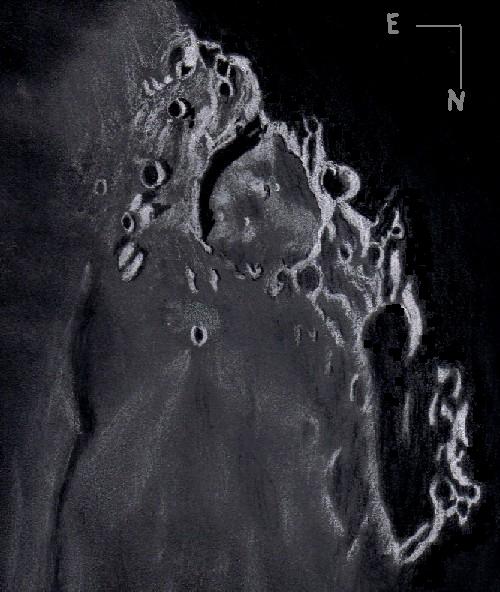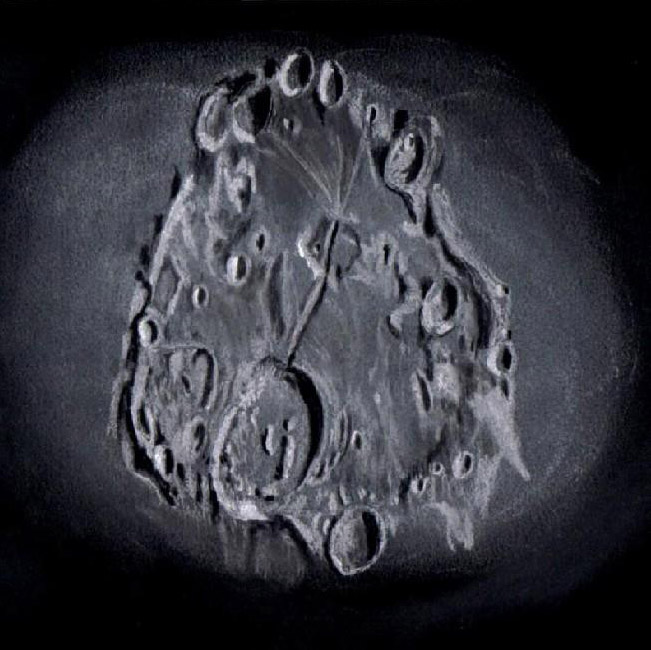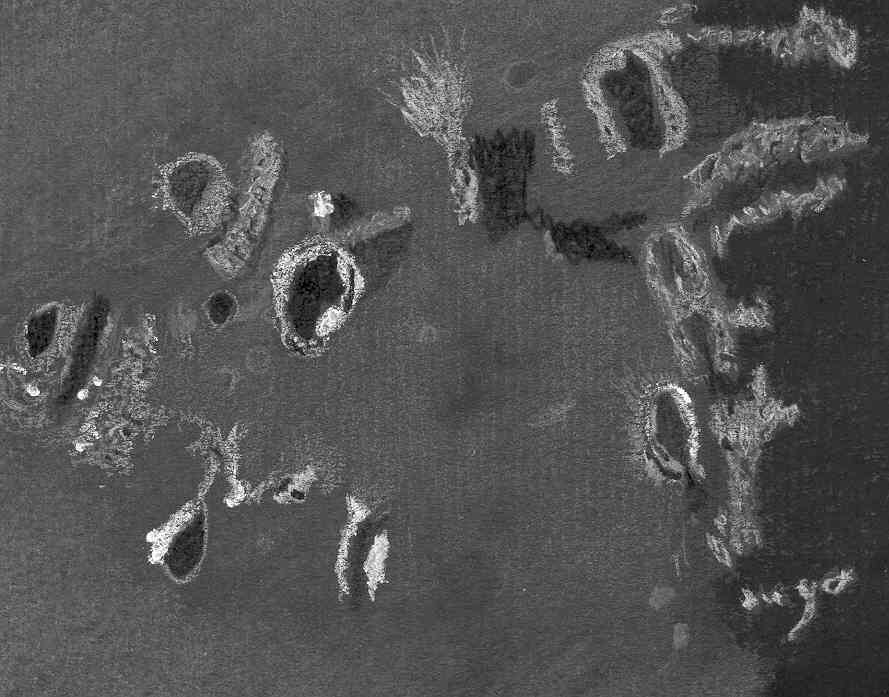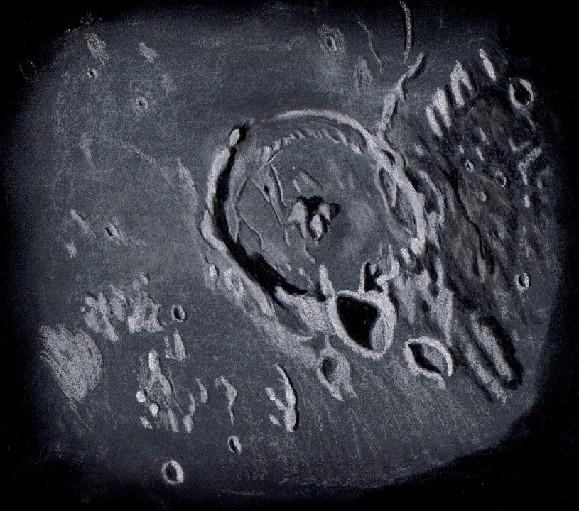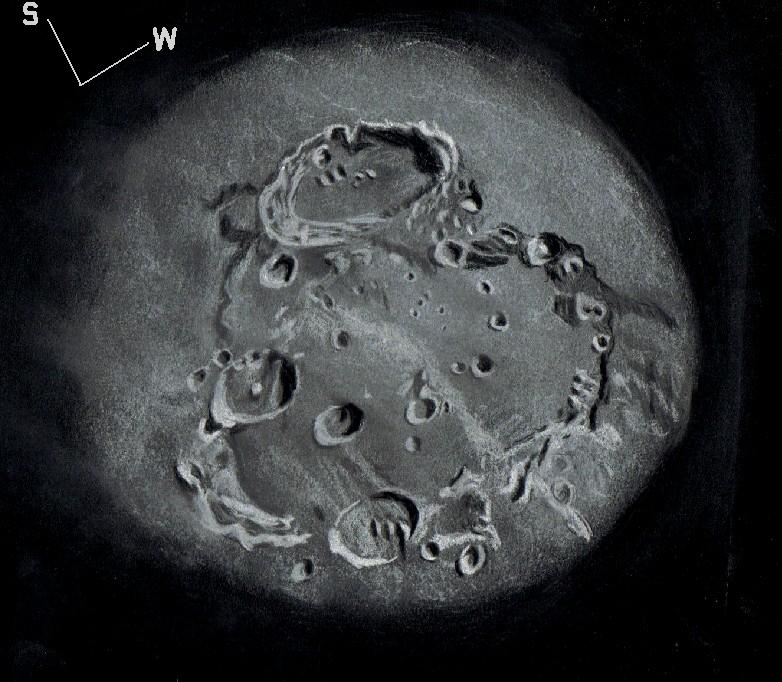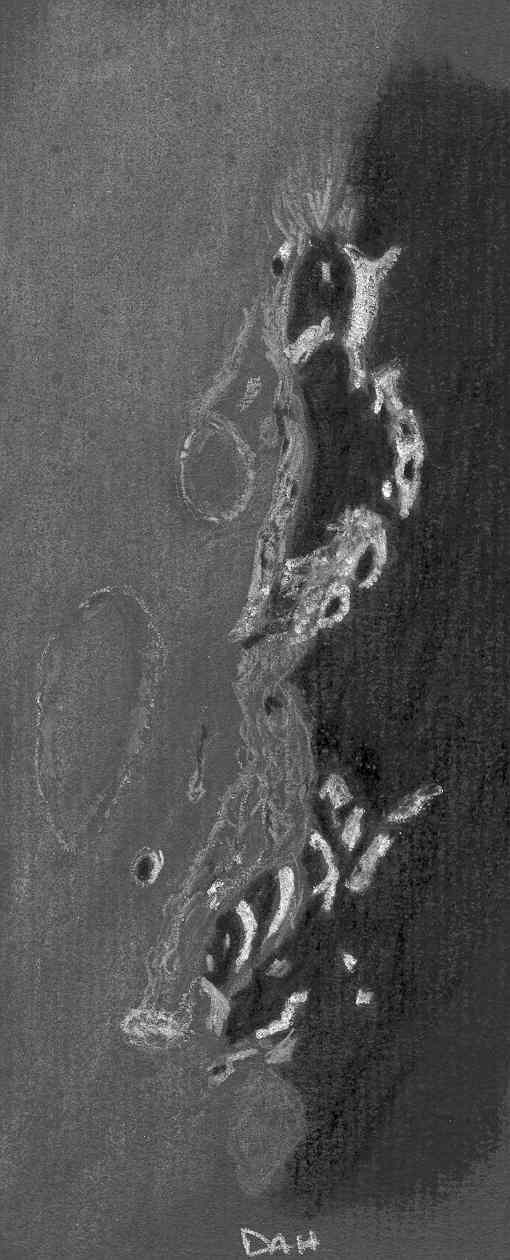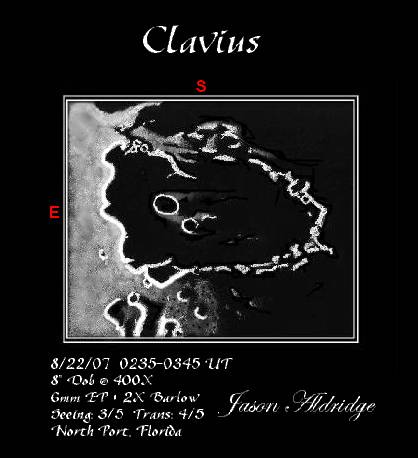South is up and west is to the left in this sketch I made this morning near
daybreak of day 27 for lunation 1048. I knew the view would be poor because I
could not wait at all for the scope’s primary mirror to cool down. Therefore I
kept the magnification low and decided to sketch the compelling region from the
Ocean Procellarum to Sinus Roris. At the top of the sketch closest to the lunar
equator and near the terminator, you can see crater Reiner a 53 km. crater and to
the west of this crater is the famous bright feature Reiner Gamma. Crater Olbers
responsible for the rays in the region is lost in the bright area near the limb.
Most of the craters in this late lunation have floors in darkness and look quite
spectacular through the eyepiece. The longest bright ray from south to north
passes east of the crater pair Cardanus and Krafft both about 50 km. in diameter.
On northward a couple of hundred kilometers and just west of the bright ray the
dark crater Seleucus can be seen and further along to the east of the ray lies Schiaparelli. Most of the remaining craters visible lie on the limb side of the continuing ray and include: large crater Russell (105 km.) with smaller Briggs and Briggs A just to the east.
Continuing on northward across the dark smooth ocean, craters Lichtenberg and
larger Lavoisier A can be seen. At this point the bright limb highlands feature
Harding and Dechen showing bright ejecta blankets near the edge of Sinus Roris. On
the terminator side dome complex Mons Rumker is about to experience sunset.
Finally at the far northern end of the sketch is Markov a 40 km crater on the
floor of Sinus Roris. Seeing the moon early in the morning late in a lunation is
always a pleasant and memorable sight.
Sketching:
For this sketch I used: black Strathmore 400 Artagain paper 12”x 7”, white and
black Conte’ pastel pencils a blending stump and my index finger too. Brightness
was slightly adjusted after scanning.
Telescope: 10” inch f/ 5.7 Dobsonian and 21mm eyepiece 69x
Date: 10-8-2007 10:30-11:15 UT
Temperature: 22° C (72° F)
Clear, calm
Seeing: Antoniadi III
Colongitude: 234.1 °
Lunation: 27 days
Illumination: 7 %
Frank McCabe
Category: White Conté on Black Paper
A tilted cup
Walled Plain Crater Fracastorius
Lunation day five has walled plain crater Fracastorius (124 km.) basking in the
morning sunlight on the south edge of Mare Nectaris as it has each lunar orbit
for more than three and three quarter billion years. The shallow plate shaped
basin that Fracastorius rests upon subsided from accumulated lava mass and this
over time tilted the crater toward the center of the basin. Eventually the lava
building up in the basin was able to find a breach in the low tilted north wall of
the crater and continued to flow in hiding the central peak and most of the north
wall beyond the breach. Some of the floor of Fracastorius is covered by lavas that
are lighter in color than the dark lava covering most of the Sea of Nectar.
Northward out into Mare Nectaris is the much younger, small (12 km.) bright rimmed
crater Rosse standing alone in this part of the lava sea.
Sketching:
For this sketch I used: black Strathmore 400 Artagain paper, white and black Conte’
pastel pencils and a blending stump. Contrast was slightly adjusted after scanning.
Telescope: 10 inch f/ 5.7 Dobsonian and 6 mm eyepiece 241X
Date: 5-22-2007 1:09-2:15 UT
Temperature: 22° C ( 72° F)
High thin clouds, calm
Seeing: Antoniadi III
Colongitude 331.8 °
Lunation 5.24 days
Illumination 32 %
Frank McCabe
Janssen and Fabricius in the Lunar Southeast
Janssen at 195 kilometers in diameter is a large ancient (4 billion year old)
walled plain crater in the southeastern highlands and is not far from the lunar
limb. Relentless moonquakes and solar system debris impacts have given this crater
its old look. The floor of Janssen is covered by numerous smaller craters. Without
trying too hard I could see 20 crater including those down to a few kilometers in
diameter. The center of the crater appears to bulge higher than the worn rim. Much
of this could be debris from the large much younger impact crater Fabricius (79
km.). Fabricius is an Eratosthenian period impact crater. It clearly shows steep
sloping walls and exhibits a central mountain range that is about 11 km. long and
also a long central ridge that is more than twice that length. Geologists tell us
that much of the debris across the floor of Janssen is Nectaris impact ejecta;
fluidized where the floor is smooth and irregular boulder-like where the floor
appears tortured. But perhaps the most interesting feature here is 140 kilometer long Rimae
Janssen. This rille looking like a graben, where it cuts through the high central
region south of Fabricius. It then narrows suddenly before reaching the rim in the
relatively smooth region of the floor. Pits that are visible via high resolution
images in these narrow regions imply volcanism. There is at least one dome on the
floor of Janssen but I was not successful in spotting it in the current
illumination. Craters Janssen and Fabricius presented fascinating features to
examine during this observation.
Sketching:
For this sketch I used: black Strathmore 400 Artagain paper, 7”x11”, white and
black Conte’ pastel pencils and a blending stump. Brightness was slightly decreased after
scanning.
Telescope: 10 inch f/ 5.7 Dobsonian and 6mm eyepiece 241x
Date: 9-29-2007 6:15-7:15 UT
Temperature: 16°C (60°F)
Clear, calm
Seeing: Antoniadi III
Co longitude: 122.1°
Lunation: 17.73 days
Illumination: 91.4 %
Frank McCabe
Like a Tart
“She appears like a tart that my cooke made me last weeke, here a vaine of bright
stuffe, and there of darke, and so confusedlie all over. I must confess I can see
none of this without my cylinder”.
These were the honest words of William Lower an amateur astronomer written upon
observing the Moon with his new “perspective cylinder” in 1608.
In the history of Man Kind this is but a heart beat in time but how the telescope
has evolved from that primitive Galilean spy glass that only the privileged few
could ever hope to own! Now even the most modest instrument delivers views of the
heavens and Moon in particular that our astronomical forefathers could only have
dreamt of!
One thing that hasn’t changed for me and countless others is the “confusedlie” of
the Moon. It is an awe-inspiring yet bewildering sight to all but the most
experienced lunar observer. I myself am very much a Lunar apprentice and each time
I fly over the terminator with my telescope and settle upon “she who takes my
heart” I am learning my way around not only the shadows, bright ridges and crater
rims but through my post sketch research feature names, dimensions and geological
composition.
On the late evening my visual voyage of 250,000 miles at the eyepieces of my
binoviewer was just such an adventure.
I deliberately selected a relatively demure region, shunning the bright and large
craters in a deliberate attempt to stray from the well trodden path.
It turns out that my target area turned out to be Lacus Exellentiae. I was
initially drawn to a crater with a brightly lit rim just to the left of centre in
my drawing that my subsequent atlas searches found as being nameless apart from
being marked as (b) in a few of the atlases I own . The crater on the right close
to the terminator however turned out to be Clausius with a diameter of 24km and
was situated close the controlled crash site of the European Smart -1 Lunar
orbiter on September 3rd 2006.
A happy hour spent and no longer so Confusedlie!
Moon 11 days
14″ (350mm) Newtonian 193x
Sketch with Derwent watercolour pencils, Derwent Pastel pencils & conte hard
pastels. Blending stumps used, sketch on lightweight black card.
Finished worked scanned but un processed.
Dale Holt
Chippingdale observatory, Nr Buntingford, Hertfordshire UK
A Lunar Favorite
Gassendi Crater, a Lunar Favorite
Protruding inside the northern rim of the sea of moisture is the large floor
fractured crater Gassendi. If you close your eyes and try to picture in your mind
a large lunar crater, the image may look something like Gassendi. The 114 km.
walled plain crater is shallow as a result of lava upwelling across the floor
especially toward the east where the highest concentrations of floor fractures are
crisscrossing. The shallow south end is tipped facing the center of Mare Humorum.
The northern end of the crater floor is rubble strewn and hummocky. The eastern
floor sports ridges and small craters in addition to rilles which were clearly
visible in the good seeing of the evening. The southern floor has an irregular
ridge that is parallel to the low rim. The large central peaks (1.2km. high) and
several smaller ones were seen in good relief with sharp black shadows. The deep
crater Gassendi A on the north rim of the larger Gassendi contrasted nicely with
respect to depth.
Shallower and smaller Gassendi B was just north-north-west of A. The rough
highlands around Rimae Mersenius were visible to the west of these three craters
and low hills in the Herigonius region could be seen to the east of Gassendi. Mare
Humorum is estimated to be 3.9 billion years old and Gassendi perhaps 100 million
years younger. If Apollo 17 planners had chosen Gassendi as the last lunar landing
site we would likely know the ages today.
Sketching
For this sketch I used: black Strathmore 400 Artagain paper, 9”x12”, white and
black Conte’ pastel pencils and a blending stump. Brightness was slightly
decreased after scanning.
Telescope: 10 inch f/ 5.7 Dobsonian 6mm eyepiece 241x
Date: 9-23-2007 2:05-3:15 UT
Temperature: 17°C (62°F)
Clear, calm
Seeing: Antoniadi II
Co longitude: 47.5°
Lunation: 11.6 days
Illumination: 82.7 %
Frank McCabe
Lunar eclipse duet
I had wonderfully clear weather the morning of August 28th, 2007 and was able to create a sequence of sketches of the total lunar eclipse for the ingress side of the event. Unfortunately the Eucalyptus grove in the west blocked my attempt to sketch the egress. Erika Rix graciously offered to animate this sequence for me, thank you so much Erika, you did such a wonderful job! I hope you all had a chance to witness this one, it was an awesome and colorful event.
Telescope:12″ SCT f/10
Eyepiece: 35mm Televue Panaoptic
Magnification: 87X
Medium: white Conte’ Crayon and colored pastels on black 400 series Artagain paper
Richard Handy – Sketches
Erika Rix- Animation
Classic Southern Moonscape
Craters Clavius and Blancanus
Among the large craters of the lunar southern highlands, two nearly 4 billions old
impacts stood out on this morning before my local sunrise. These craters are 225
km.diameter Clavius and smaller 109 km. Blancanus. Clavius is not only old and
large but is blanketed with numerous craters and craterlets. At the center of this
large crater are the reduced remains of once regal central peaks. The atmosphere
was steady enough to pick out cratelets less than 1.5 km in diameter during
periods of excellent seeing. Crater Clavius is famous for its semicircular crater
sequence of decreasing size beginning with 49 km. Rutherfurd at the inner
southeastern wall and continuing with 27km. D, 20 km. C, 12 km N, 11.3 km J and
7.5 km JA. The north-northeastern rim of Clavius has a large crater resting it.
This 52 km. diameter crater is Porter. A broad crater ray was clearly visible
crossing the floor of Clavius just to the west of Porter and Clavius C. Much of
the floor of crater Clavius
remains smooth which implies the flow of melted rock in the past. Some geologists
speculate it is from the ejecta of the Orientale basin. Some small secondary crater
chains point back in that direction.
Sketching:
For this sketch I used: black Strathmore 400 Artagain paper, 9”x12”, white and
black Conte’
pastel pencils and a blending stump. Brightness was slightly decreased after
scanning.
Telescope: 10 inch f/ 5.7 Dobsonian and 6mm eyepiece 241x
Date: 9-2-2007 8:15-9:25 UT
Temperature: 17°C (62°F)
Clear, calm
Seeing: Antoniadi II-III
Co longitude: 53.9°
Lunation: 20.39 days
Illumination: 70 %
Frank McCabe
From Sirsalis to Damoiseau
This was the first time that I had used my new (to me) Superscopes 6″ F9 triplet
refractor for a sketch. As per usual I sketch what my eye is most drawn to and
then research the area after.
In this case I struggled to match up the craters that I had captured with any of
my many books & atlases. In the end I got a best match from an excellent free
down load picture Atlas/portfolio by Alan Chu. I decided that it must be the
Sirsalis region although the stunning illumination I enjoyed wasn’t captured in
any thing that I had in my library.
I used the following:
Superscopes 150mm F9 triplet refractor, Denk binoviewer with 2.5x lens, 2x 23mm
Celestron Axiom eyepieces straight through so no diagonal delivering 146x.
6″x8″ (150mm x 200mm) light black card of unknown origin
Derwent watercolour pencils, Derwent pastel pencils, conte sticks & blending stumps
25.8.07, 21.30UT sketch time 10minutes.
Location: Chippingdale observatory, Chipping Nr Buntingford, Hertfordshire, England.
Dale Holt
Out of darkness into the light
When I spied the glowing rims floating in a pool of pitch, I knew it was time that I
tried to render a lunar sketch with white pastel on black paper. I felt quite clumsy
while drawing Clavius with this foreign medium, but in the end I decided that the
result was acceptable. I know that I will require a good deal of practice before I
am comfortable sketching in this manner. Kudos to those of you who make such
wonderful lunar sketches in white on black!!! I hope you all enjoy my first attempt
at sketching with new tools.
Jason Aldridge
North Port, FL
Under a waxing gibbous Moon
10 Day Old Moon
I decided before dark that this was the night to try a whole moon sketch again.
August has been cloudy and rainy since the beginning of the month. It was clear
before sunset, but clouds and rain were due in by 10 pm local time. I attempted
this type of drawing at the beginning of the year and I was unhappy with the
result. The drawing at that time was too small and I rushed it. This time I
proceeded in a similar manner but I made the drawing larger and took my time. I
also re-read chapter one in Astronomical Sketching by Richard Handy, David Moody,
Jeremy Perez, Erika Rix and Sol Robbins before I started. Rich and Erika wrote
this chapter. I did this to make sure I didn’t forget something important. To make
this sketch I needed a small scope so I used the finder scope of my 18” which
doubles as a 4.25” f / 5 Dobsonian. Some of my favorite views of the moon have
occurred using telescopes of this aperture and smaller.
Sketching:
For this sketch I used: black Strathmore 400 Artagain paper, white and black Conte’
pastel pencils and a blending stump and my index finger too. Brightness was
slightly adjusted after scanning.
Telescope: 4.25 inch f/ 5 Dobsonian and 21mm eyepiece 26x
Date: 8-23-2007 0:45-2:40 UT
Temperature: 30° C (86° F)
Partly cloudy, calm
Seeing: Antoniadi III
Colongitude: 27.9 °
Lunation: 10 days
Illumination: 69.4 %
Frank McCabe



